Formic Pro and Queens in Hot Weather
A trick for using formic pro on weak colonies 2
Why would queens be more susceptible to formic than workers?. 6
A test of queen loss in tiny colonies. 7
Taking advantage of opportunity. 10
Trial #1 — Would foil covers reduce queen loss or turnover?. 11
Trial #2 — Does covering the strips affect efficacy?. 12
Formic Pro and Queens in Hot Weather
First published in ABJ in September 2022
Randy Oliver
ScientificBeekeeping.com
Formic acid has a lot going for it when used for varroa management. A recurring question is how to avoid the common complaint about queen loss, especially when applied during hot weather. I recently had the chance to run three impromptu “quick and dirty” experiments to investigate.
Formic for mite management
Beekeepers worldwide have long used formic acid — applied by various methods — for control of varroa. Formic is able to achieve rapid mite reduction — and notably, kill mites beneath the cappings — while not contaminating the combs or honey. My sons and I use it extensively in our operation (in rotation with oxalic acid and thymol), and have experimented with a number of application methods, including Formic Pro strips.
Since the recommended temperature range for application of Formic Pro lies between 50 and 85°F (10-30°C), using it during summer may be problematic. There is a common concern about formic causing queen loss (or inducing queen turnover) during hot weather.
Practical notes:
- In my 2020 hot-weather trial [[1]], although a number of colonies replaced their second-year queens after treatment with Formic Pro, 28 out of 29 had a laying queen a month after the second application of a strip.
- Formic acid is great for springtime treatment, since its induced brood break may help to avert swarming, and colonies can easily replace a lost queen at that time of year.
- The release rate of formic acid from Formic Pro is essentially the same as that from Mite Away Quick Strips [[2]], so the results of the experiments below would likely apply to either type of strip.
A trick for using formic pro on weak colonies
I routinely treat nucleus colonies with Formic Pro strips, even in hot weather. A trick for preventing queen loss is to press the hive cover down tight onto the top of a half strip (Figure 1).
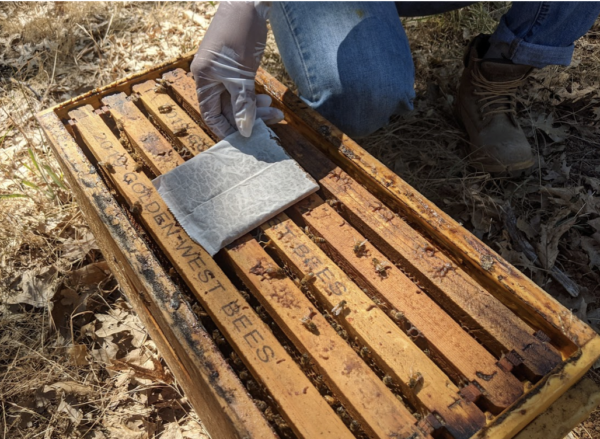
Fig. 1 A nuc can be treated with a half strip of Formic Pro, if the top surface is tightly pressed on by the hive cover.
Take a look at the photo above. Note that evaporation from the bottom side of the strip is largely blocked by the top bars. If evaporation on the upper surface is blocked by the hive cover, that leaves only the outer edges and two 3/8” strips from which the fumes can escape. This greatly slows and extends the release rate of the formic acid. Unlike strips placed between two brood chambers, which rapidly gas off and dry to stiffness, strips placed directly under the cover as above, will even after 10 days of hot weather still be soft and outgassing formic acid (Figure 2). It’s important to press the hive cover down firmly over the strip (Figure 3).
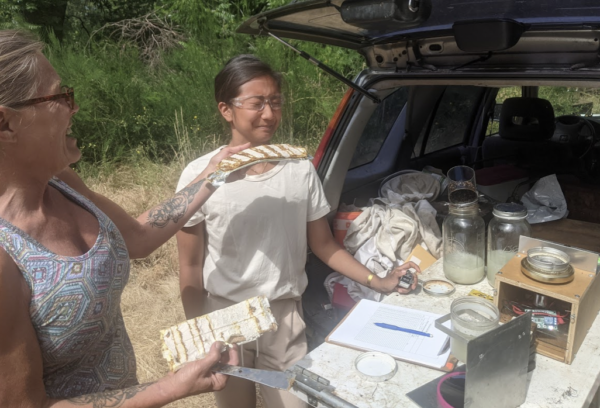
Fig 2 Tammy giving Rose her first introduction to formic vapors. These strips had been in hives for 10 days, with their foil cover placed on top. As you can see from the grimace on Rose’s face, there were still fumes being emitted. The ladies are standing at our mobile mite wash station.
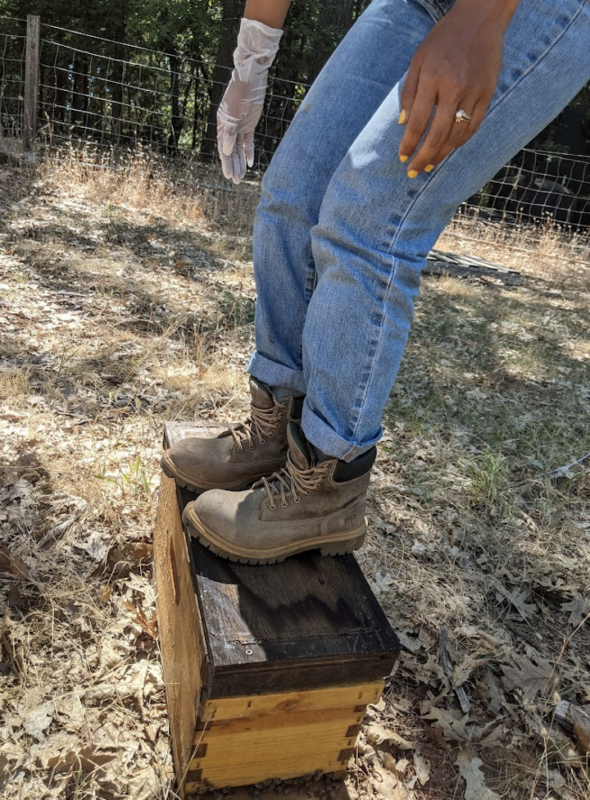
Fig. 3 Helper Rose Pasetes performing a balancing act while demonstrating the pressing method that we use for the nuc cover. Caution: this dangerous technique should only be used with appropriate safety equipment to prevent falls [[3]].
Practical application: The label directions for treatments don’t necessarily cover all the “tweaks” necessary for optimal application under various conditions and situations. Small adjustments to an application method can make a big difference!
Queen loss in hot weather
Despite the temperature recommendations, during our increasingly-hot summers, we still sometimes need to get the mite count down quickly in a colony, and formic fits the bill. We often apply a single Formic Pro strip during hot weather for a “knockback” treatment while honey is still on the hive, and don’t observe queen problems. And once we’ve pulled honey, we routinely break high-mite colonies with second-year queens down into singles, and then blast them hard with a strong formic treatment when the temperature is in the high 90s. A handful of (presumably weak, old, or newly-emerged) dead workers in front of the hive the next day indicates that an adequate dose was applied, but surprisingly, even with these extreme formic blasts, the (unwanted) queens still often survive!
Why would queens be more susceptible to formic than workers?
So why, of all the bees in the hive, would the well-fed and long-lived queen be the most susceptible individual to formic acid? It’s easy to observe that queens simply move away from irritating fumes. I’ve long been curious about an observation by Amrine & Noel [[4]], during their development of the 50% formic “flash” treatment:
Essential oil components in Honey-B-Healthy [consisting of spearmint and lemongrass oils] modify the effect of Formic Acid (FA) treatment on bee hives, such that queens are not lost. This aspect is extremely important for any beekeepers using formic acid to treat varroa mites.
The idea for using lemongrass oil may have come from a prior study by one of Amrine’s students. Vargas-Sarmiento [[5]] found that although application of lemongrass oil could cause queen supersedure on its own, it appeared to suppress the removal of foreign material from the hive.
To my great surprise, I can’t find follow up research on using essential oils to mitigate queen loss when using formic. This is especially surprising because both oils exhibit miticidal properties in their own right [[6],[7],[8]], so adding them might also improve the efficacy of formic acid treatment.
Practical application: Could it be that the queen loss associated with formic treatment is due to the workers, in response to the stress from formic vapors, killing the queen themselves? Or perhaps, since formic fumes kill all the eggs and very young larvae, is the resulting sudden reduction in young brood pheromone a cue that triggers the bees to supersede an apparently failing queen?
And could lemongrass oil, which contains some of the same components as orientation pheromone, suppress such behavior? I’ve been wanting to test the effect of adding these essential oils to formic treatment for some time, but first need to determine an application method that consistently kills queens.
To that end I’ve placed queens into push-in cages directly below formic applications, and found that even if they were constrained from moving away from the fumes, some queens survived even when workers in the same cage died (Figure 4).
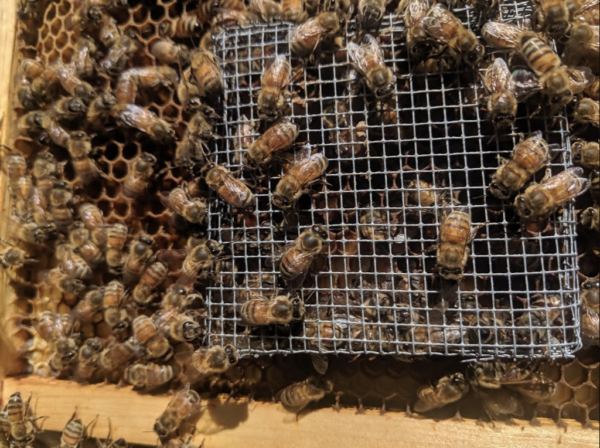
Fig. 4 You can see the dead workers in this cage, but I was unable to get the still-living queen to pose for the photo. It surprised me to find that queens in push-in cages could sometimes survive being placed directly below strong formic applications, with or without attendants in the cage.
And then in June I had an unplanned opportunity to run a spontaneous test…
A test of queen loss in tiny colonies
Assisted by Tammy Hayden and Rose, I was setting up colonies in an outyard for an experiment, when my son Eric called to say that he was heading over to formic blast some “dinks” in the same yard. The colonies (made from splits with queens in their second year) had never built up, and he hoped to both kill the mites as well as the poor queens with the treatment, before adding the boxes to other hives . Realizing an opportunity, I asked him to grab some push-in cages to bring along, but he couldn’t find them, so brought some JZs BZs introduction cages instead.
The colonies were all weak and in single deeps. We quickly found and caged the queens, pressing them into a center comb to be replaced directly below a single Formic Pro strip (Figure 5).
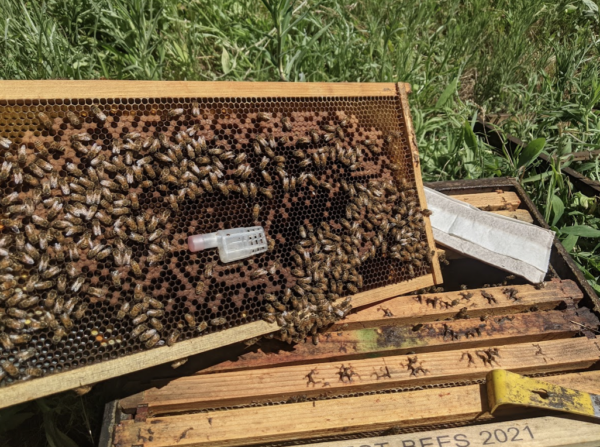
Fig. 5 These “dink” colonies all had second-year queens, and most had poor brood patterns. The weather was hot and dry. We placed the queens in cages without candy or attendants (which if we’d had the push-in cages, we’d have done differently).
Practical application: Many of us have noticed that formic tends to “knock out” poor queens more so than young high-quality queens. So we’re not concerned about the loss of poorly-performing queens.
Not wanting to kill the brood in the weaker colonies, and knowing how the pressing of the lid on top of a strip reduces queen loss, the boys placed 1.5” rims only on the stronger colonies (Figure 6) (to allow for more evaporation from the strips. This proved to make a big difference.
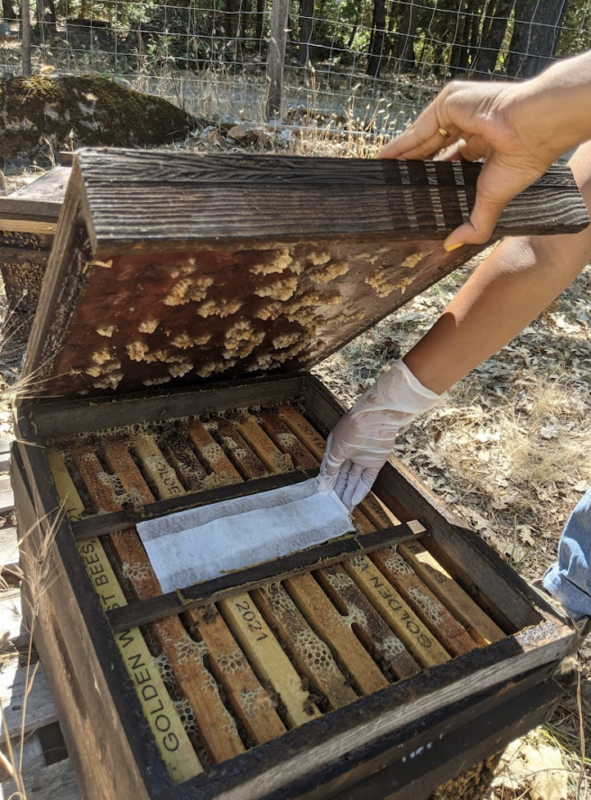
Fig. 6 Rose placing a strip in a 1.5” spacer rim. For the weaker colonies, we pressed the migratory cover directly on top of the strips.
Important note: All hives used in the trials in this article had unrestricted 3/4” high entrances.
We checked two days later for queen survival (Table 1).
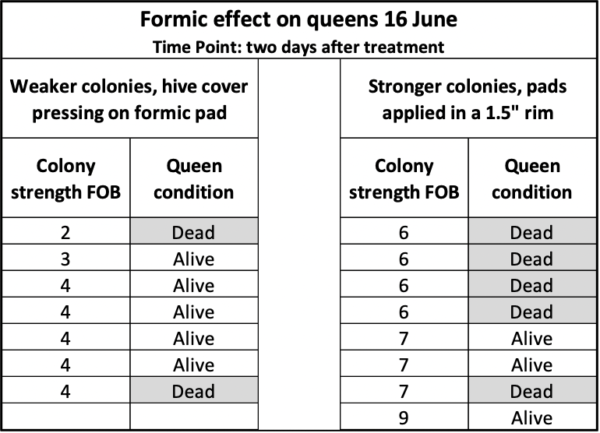
Table 1. Note the higher survival rate of the queens in the weaker colonies. I can’t say for sure, but the variable of restricting evaporation from the top of the strips appeared to make a difference.
Practical application: Had Eric been able to find push-in cages, I would have supplied the queens with food and attendants. So I can’t say whether the queens died from the formic fumes, or due to not being fed through the cage openings, but there was clearly a direct or indirect effect of formic upon some queens. I still need to test for the effect of adding essential oils.
The above was not the only opportunity to arise for an unplanned experiment…
Taking advantage of opportunity
Shortly after the above experiment, my helpers and I had taken final mite wash counts from colonies in two different trials (one yard having been treated with different kinds of oxalic dribbles, the other with an experimental thymol gel). Since some of the mite counts were still high at the end of the experiments, we planned to hit those colonies immediately with formic acid.
It occurred to me that those ending mite counts could serve as starting counts for new field experiments with formic, if we started them immediately. So I made the spur of the moment decision to take advantage of this opportunity to follow up on my observation of the substantial amount of queen replacement that occurred in my testing of Formic Pro in hot weather last year.
Practical application: Bees initially move away from formic fumes and fan, but very quickly get used to the odor (and presumed irritation), and even walk right over active strips. Queen “turnover” appears to be due to the initial high-intensity “flash” of vapors that occurs with most application methods. Perhaps by controlling the initial “flash” (similar as to how we treat nucs) we may be able to reduce queen issues.
Experimenting with ways to reduce the initial flash, I thought of using the foil wrapper that Formic Pro strips come packaged in to simply cover the upper surface of the strip when applied between two brood chambers. So last year I measured the rate of weight loss of a couple of pairs of Formic Pro strips placed in a double deep of drawn combs (without bees, to avoid both the variable of fanning, as well as weight gain from propolis deposition) during hot weather, covering one of each pair with its foil wrapper. The results are shown in Figure 7.
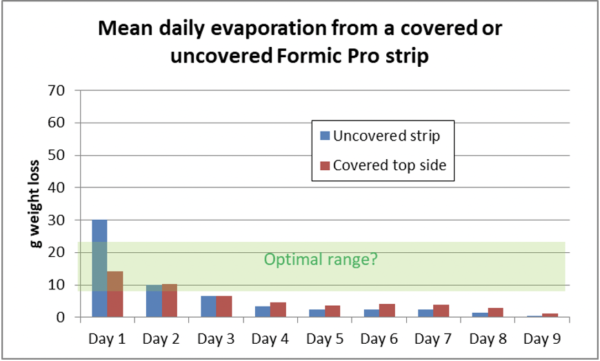
Fig. 7 Covering the upper surface of a strip with its wrapper reduced its daily weight loss (from the release of the formic vapors). This greatly reduced the first-day “flash,” and extended the lower-level release afterwards. Could this method of application improve the treatment?
Practical application: Over the years I’ve measured the daily release rate of formic acid from various application devices and methods. After extensively reviewing published and unpublished studies, it appears that the optimal continuous-release application rate for 65% formic acid is somewhere in the range of 8-22 g per day (as indicated in Figure 6), depending upon ambient temperature, colony strength, and entrance restriction. That said, we’ve treated a lot of hives with the old Mite Away II strips, which released 30-50 g per day, and overnight flash treatments of up to 90 g of 50% formic [[9]].
Back to us having two yards with starting mite counts, it occurred to me that this was an opportunity to test covering the strips in colonies with bees to see whether it reduced the amount of queen turnover. So we started two ad hoc, hastily-planned experiments — one focusing upon queen loss, the other focusing upon efficacy.
Trial #1 — Would foil covers reduce queen loss or turnover?
We ran both trials starting on June 24, during our honey flow. All colonies had been started from nucs with second-year queens. Due to awful weather during their buildup period, the colonies were still relatively weak, all in double deeps with the brood in the lower box, and the bees just starting to work into an upper box containing frames of foundation (we gave a few of the stronger colonies a honey super at the second formic application). Helped additionally by Corrine Jones, we applied formic strips, centered over the clusters, so the combs with brood got direct exposure to the fumes (Figure 8).
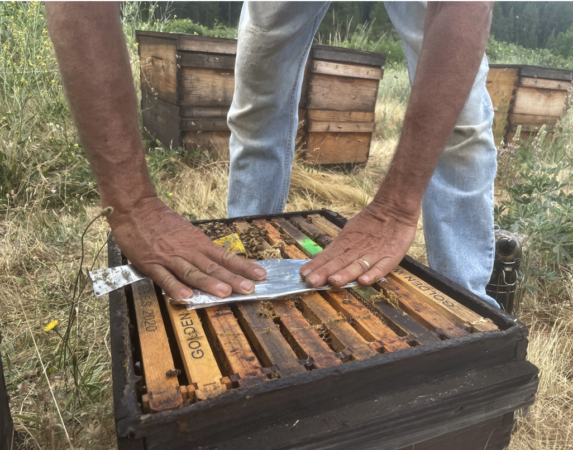
Fig. 8 We ran this trial during hot weather, with daily highs often in the upper 90s (35C+). The colonies in this yard were the stronger of the two, and had higher mite counts, so we wanted to give them a double application of Formic Pro, with a second strip applied after 10 days (replicating the 2020 field trial). In this yard, we covered the tops of the Formic Pro strips with their wrapper in all the colonies in order to reduce evaporation from the upper surface (I opened the wrappers carefully and cut each in half).
Trial #2 — Does covering the strips affect efficacy?
I hadn’t planned either of these spontaneous trials, and made up the protocols as we were driving to the yards. The colonies in the second yard had lower mite counts overall, so in this yard we ran Test and Control groups — with the strips either covered or uncovered. I haphazardly assigned treatments as we applied them, using the full wrapper, pressed flat, to cover one of each pair of strips. Once home, I noticed that based upon the May counts that were still on the hives from the previous experiment, that I’d wound up over-favoring the lower-mite colonies with the uncovered strips (so they could not be used as proper Controls in order to calculate efficacy).
Sampling timing explanation: Since what I was interested in with this experiment was the effect of covering the strips upon efficacy at mite reduction, we only treated once, taking final mite counts 21 days after application of a single strip, which allowed for mites that survived treatment while they were in the brood to emerge, and reestablish the equilibrium of the proportion of mites in the brood relative to those on adult bees, so that a mite wash of adult bees would again reflect the overall mite population in a hive. Details, details, details…
Results
Trial #1
Unlike what occurred in my hot-weather trial of Formic Pro in 2020 [[10]], in which there was a goodly amount of queen “turnover,” in this experiment, every single queen was still alive and had plenty of young brood 10 days after the application of the second strip. Go figure!
As far as reduction in the mite infestation rate of the adult bees, the mean (as well as the median) reductions in mite counts were around 54%. This figure is roughly the same as we obtained in 2020 (85% median reduction, 54% mean). Since the colonies varied considerably in strength, I sorted the results by ending colony strength (Figure 9), to see whether cluster size affected mite reduction.
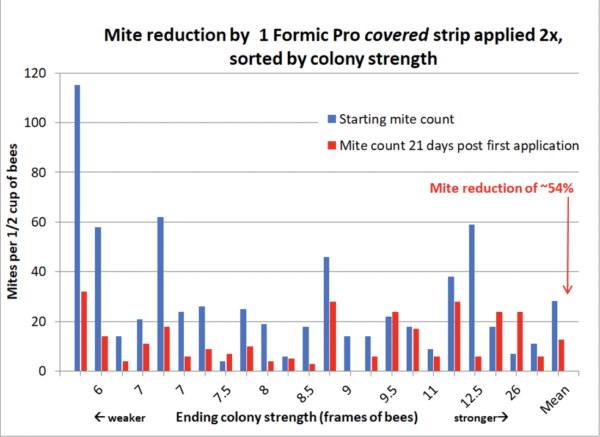
Fig. 9 I didn’t run a control group, so can’t compute efficacy, but can show the degree of mite count reduction at 21 days (10 days after application of the second strip), by which time most remaining live mites in the brood would have emerged. On average, mite counts dropped by slightly more than half, and were reduced in nearly all the colonies, but there was considerable variation. Note that you see less red relative to blue on the left, indicating that the treatment tended to be somewhat more efficacious in the weaker colonies, in which most of the cluster was located below the strip.
Practical applications: Once again there is great hive-to-hive variation in the amount of mite reduction due to this treatment method. But unlike as in 2020, not a single queen got replaced. But was that due to covering the strips?
Trial #2
In this trial, with only a single strip applied to relatively weak colonies, at 21 days after application, we lost no queens in the 11 covered-strip colonies. But surprisingly, we lost only 1 queen out of 12 in the uncovered strip group (in one of the stronger colonies). So it’s hard to attribute the lack of queen loss in Trial #1 to covering the strips.
Practical application: I have no idea as to why we didn’t see as much queen turnover this year, but covering the strips didn’t appear to make much difference in relatively weak colonies with plenty of room in the second brood chamber.
So how about the effect of covering the strips upon efficacy in mite reduction? Three weeks after applying a single strip, both groups in this yard averaged roughly the same mite counts that they started with, but again with wild variation (Figure 10).
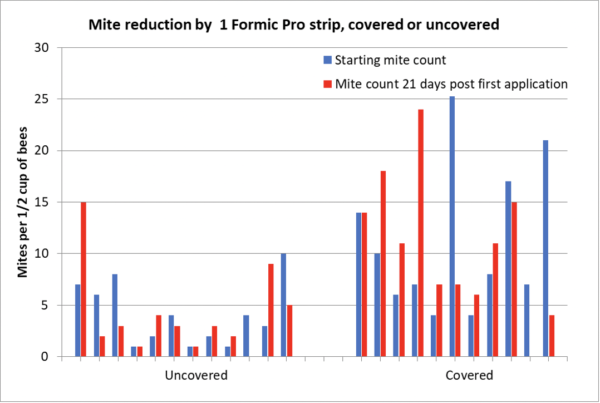
Fig. 10 As far as mite reduction, we didn’t get much from a one-strip “knockback” treatment. There was again considerable hive-to-hive variation, and again I have no idea as to why. I hesitate to draw any conclusions as far as efficacy against varroa, since these were relatively weak (and well-ventilated) colonies.
Wrap up
Allow me to first make abundantly clear that in the above experiments we were applying Formic Pro at well above the recommended temperatures on the label, so its relatively moderate efficacy would not necessarily reflect its performance when applied at lower temperatures.
That said, we observed only a single queen being lost out of 47 treated colonies. I have no explanation as to why our colonies, treated with the same application of Formic Pro, in similar yards at similar temperatures, had such different rates of queen turnover when replicated in two different years.
Nor do I understand the inconsistency in mite reduction with Formic Pro, but suspect that it has something to do with colony ventilation. Once ambient temperature exceeds broodnest temperature (95°F; 35°C), colonies are heat stressed and must increase fanning and evaporation within the hive (but varroa mites are also stressed above this temperature [[11]]). Thus the hive-to-hive variation in mite reduction may have to do with differences in fanning behavior.
There appears to be a fine line, especially during hot weather, between the intensity of exposure to formic acid that it takes to kill the mites under the cappings, and that which causes queen issues. Underwood’s [[12]] research suggested that “queens are affected by acute rather than chronic exposure to formic acid,” and this observation has been confirmed by many others. The trick for formic application appears to be to slow down the initial flash of vapors, while providing an extended lower level of fumigation to chip away at the mites. Along this line, we did so by covering the strips with their wrappers. As I type these words, I’m thinking that perhaps we should also have reduced the entrances (and may return to those yards today to run another experiment).
Since Formic Pro and Mite Away Quick Strips are the only registered formic acid products in the U.S., and since our summers don’t appear to be getting any cooler, it’s likely worthwhile for us to keep experimenting to figure out how best to use them if we need to attain quick knockdown of mites during hot weather.
Practical note: We’re still experimenting with extended-release oxalic acid. This application method takes about two months to attain full efficacy, and in our informal tests, appears to work well in combination with a simultaneous application of formic acid. We need to collect more data on this…
Citations and notes
[1] https://scientificbeekeeping.com/mite-control-while-honey-is-on-the-hive-part-3/
[2] https://scientificbeekeeping.com/mite-control-while-honey-is-on-the-hive-part-3/
[3] Hey, I gotta cover my butt against lawsuits.
[4] Amrine Jr, J, & R Noel (2006). Formic acid fumigator for controlling varroa mites in honey bee hives. International Journal of Acarology 32(2): 115-124.
[5] Vargas-Sarmiento, M (2000). Essential oil treatments to control Varroa destructor Anderson and Trueman 2000 (formerly Varroa jacobsoni Oudemans 1904)(Mesostigmata: Varroidae). West Virginia University.
[6] Islam, N, et al (2016) Management of Varroa destructor by essential oils and formic acid in Apis Mellifera Linn. colonies. Journal of Entomology and Zoology Studies 4(6): 97-104.
[7] Ariana, A, et al (2002). Laboratory evaluation of some plant essences to control Varroa destructor (Acari: Varroidae). Experimental & Applied Acarology 27(4): 319-327.
[8] Refaei, G (2018). Comparing effect of plant-derived oils on Varroa destructor Infesting honeybee, Apis mellifera. Acarines: Journal of the Egyptian Society of Acarology 12(1): 61-64.
[9] https://scientificbeekeeping.com/messin-with-varroa-2014/
[10] https://scientificbeekeeping.com/mite-control-while-honey-is-on-the-hive-part-2/
[11] https://scientificbeekeeping.com/a-test-of-thermal-treatment-for-varroa-part-1/
[12] Underwood, R & R CURRIE (2007) Effects of release pattern and room ventilation on survival of varroa mites and queens during indoor winter fumigation of honey bee colonies with formic acid. Canadian Entomologist 139: 881–893.



